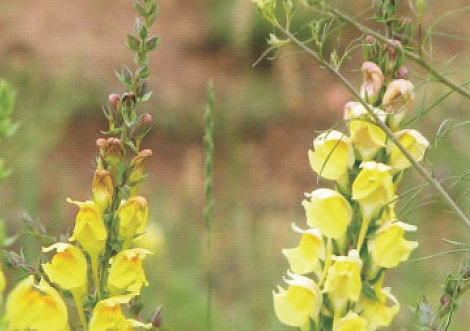Damnation Toadflax, Or How Pretty Plants become Problem Pests
Even a plant-lover, and I do consider myself such, can be challenged by some species, and the mellowest of us can be pressed into trophy hunting when circumstances are right. Summer is the season for bagging the biggest baddest trophies in our neck of the woods. Each year I’ve been going after my limit, but of course, you never run out of this bad boy. Its beauties, and I’ll grant there are some, are only petal-deep.
The object of my disaffection and prejudice this season, as in years past, is Dalmatian Toadflax (variously Linaria dalmatica, Linaria genistifolia ssp. dalmatica, etc.) This gorgeous yellow snapdragon is fast becoming one of the dominant foothills wildflowers of early summer. Its cousin, Linaria vulgaris (usually known as butter-and-eggs) is less robust in stature but equally  capable of taking over property. It seems to prefer moist areas, while Dalmatian toadflax is doing just fine, thank you, on drier foothills slopes. According to Colorado State University, the two together occupy about 75,000 acres in Colorado, and “Toadflax invasion is favored by disturbance and they invade degraded areas such as roadsides, abandoned lots and fields, gravel pits, clearings, and overgrazed rangeland. In Colorado, these weed species are found at elevations from 5,000 feet to over 10,000 feet.” [Biology and Management of the Toadflaxes, by K.G. Beck]
capable of taking over property. It seems to prefer moist areas, while Dalmatian toadflax is doing just fine, thank you, on drier foothills slopes. According to Colorado State University, the two together occupy about 75,000 acres in Colorado, and “Toadflax invasion is favored by disturbance and they invade degraded areas such as roadsides, abandoned lots and fields, gravel pits, clearings, and overgrazed rangeland. In Colorado, these weed species are found at elevations from 5,000 feet to over 10,000 feet.” [Biology and Management of the Toadflaxes, by K.G. Beck]
How did it get here in the first place, you may ask. Remember its good looks. Like many of our noxious weeds, this Mediterranean native was introduced as an ornamental, as early as 1874 here in the western U.S. We can only hope we’re learning to be a little more cautious about those pretty faces we bring home from the greenhouse or nursery… be on the lookout!
That this Eurasian species has taken over most of the United States is documented here, by the USDA Plants database (plants.usda.gov). Grey color indicates its non-native status in the U.S. In Colorado, I suspect it occurs in many more counties than shown in the USDA map. Toadflax is sneaky, competitive, prolific, and adaptable. Heaven help our native flora! [Map source: plants.usda.gov]
Controlling toadflax
Although experts often say “don’t pull it—it just makes it come back stronger,” that never made sense to me. First, if one can get some of the underground parts, repeated pulling has to, in time, exhaust the plant’s energy. The key is “repeated.” Pulling must continue for 5-6 years to remove root fragments, and lateral roots also need to be followed and removed. Not a task for the faint of heart. Most land managers find “one-shot” spraying easier, as it avoids that constant responsibility. Second, if you can prevent the plant from setting seed, it seems that could also help; after all, one healthy mature Dalmatian toadflax plant can produce 500,000 seeds, some of which can remain present in dead stalks for up to two years.
So I started an experiment in my own neighborhood, ruthlessly attacking every sprig I could find while out walking around the block, especially after rain. Pulling weeds is so satisfying when the ground is wet, and you really feel like you’re getting results! When it’s dry, and stems snap off at ground level, you have to suspect your efforts are futile.
Hypothesis: Control of Dalmatian toadflax can be achieved by repeated, diligent hand-pulling.
Methods: Repeated diligent hand-pulling, wherever, whenever, but especially in the immediate home territory.
Goal: A reduction in the local population, or (at the least) a drastic decline in recruitment of new individuals by seed. If one can only keep them from flowering, that has to help, right?
Results: Bags of garbage, at least the inflorescences of which have to be treated like the hazardous waste they are, and the opportunity to have roadsides free of these yellow snapdragons! And, I truly believe, considerable success in knocking local populations back and preventing their expansion.
Thus the “bagging” of trophies is literal here, and like any good hunter, I felt compelled to document my success—so here’s the traditional shot of selections from my daily limit. (No, I resisted the impulse to have my picture taken holding them by the roots…)
Of course, you could also spray, and several options are available for that (consult an expert for advice on this option). As another approach, at least eight different insects have been introduced for biological control; many of these are available from the Colorado Department of Agriculture, which operates an insectary in Palisade. These include beetles that feed on shoots and flowers, reducing seed production, defoliating moth, and stem- and root-boring weevils and moths. Every little bit helps. But remember, you too can be a biological control agent at home, where you can keep an eye out and attack stragglers.
So this spring, I ventured out again, attracted by a few sprigs of yellow that had survived my earlier treatments. With soil freshly wet by rain, I was ready to pull—but in the end I stayed my hand. The plants I was about to pull had problems already; they were mere shadows of the robust weeds I expected. Weak, spindly, and browning, they were already under attack. Knowing that weevils and moths had been introduced nearby in previous years, I opted to leave the offending plants in hopes that the insects would triumph! I returned to check in mid-August, to find plants that, despite recent rains, looked nothing like their former selves. Seed pods, if present, were tiny, and one plant would be hard pressed to muster 50 seeds if it produced any. Suddenly, I’m encouraged! Maybe the spread of these damnation toadflaxes can be checked after all.
Copyright © 2013 Sally L. White
Discover more from PLANJeffco
Subscribe to get the latest posts sent to your email.




Leave a Reply
Want to join the discussion?Feel free to contribute!